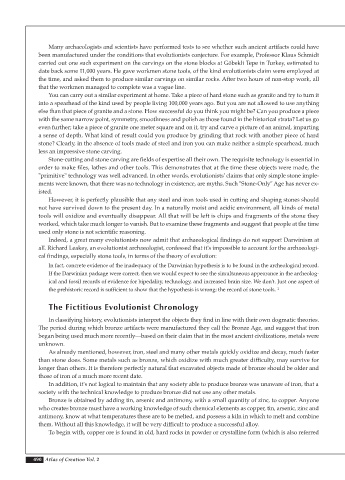Page 492 - Atlas of Creation Volume 2
P. 492
Many archaeologists and scientists have performed tests to see whether such ancient artifacts could have
been manufactured under the conditions that evolutionists conjecture. For example, Professor Klaus Schmidt
carried out one such experiment on the carvings on the stone blocks at Göbekli Tepe in Turkey, estimated to
date back some 11,000 years. He gave workmen stone tools, of the kind evolutionists claim were employed at
the time, and asked them to produce similar carvings on similar rocks. After two hours of non-stop work, all
that the workmen managed to complete was a vague line.
You can carry out a similar experiment at home. Take a piece of hard stone such as granite and try to turn it
into a spearhead of the kind used by people living 100,000 years ago. But you are not allowed to use anything
else than that piece of granite and a stone. How successful do you think you might be? Can you produce a piece
with the same narrow point, symmetry, smoothness and polish as those found in the historical strata? Let us go
even further; take a piece of granite one meter square and on it, try and carve a picture of an animal, imparting
a sense of depth. What kind of result could you produce by grinding that rock with another piece of hard
stone? Clearly, in the absence of tools made of steel and iron you can make neither a simple spearhead, much
less an impressive stone carving.
Stone-cutting and stone carving are fields of expertise all their own. The requisite technology is essential in
order to make files, lathes and other tools. This demonstrates that at the time these objects were made, the
"primitive" technology was well advanced. In other words, evolutionists' claims that only simple stone imple-
ments were known, that there was no technology in existence, are myths. Such "Stone-Only" Age has never ex-
isted.
However, it is perfectly plausible that any steel and iron tools used in cutting and shaping stones should
not have survived down to the present day. In a naturally moist and acidic environment, all kinds of metal
tools will oxidize and eventually disappear. All that will be left is chips and fragments of the stone they
worked, which take much longer to vanish. But to examine these fragments and suggest that people at the time
used only stone is not scientific reasoning.
Indeed, a great many evolutionists now admit that archaeological findings do not support Darwinism at
all. Richard Leakey, an evolutionist archaeologist, confessed that it's impossible to account for the archaeologi-
cal findings, especially stone tools, in terms of the theory of evolution:
In fact, concrete evidence of the inadequacy of the Darwinian hypothesis is to be found in the archeological record.
If the Darwinian package were correct, then we would expect to see the simultaneous appearance in the archeolog-
ical and fossil records of evidence for bipedality, technology, and increased brain size. We don't. Just one aspect of
the prehistoric record is sufficient to show that the hypothesis is wrong: the record of stone tools. 1
The Fictitious Evolutionist Chronology
In classifying history, evolutionists interpret the objects they find in line with their own dogmatic theories.
The period during which bronze artifacts were manufactured they call the Bronze Age, and suggest that iron
began being used much more recently—based on their claim that in the most ancient civilizations, metals were
unknown.
As already mentioned, however, iron, steel and many other metals quickly oxidize and decay, much faster
than stone does. Some metals such as bronze, which oxidize with much greater difficulty, may survive for
longer than others. It is therefore perfectly natural that excavated objects made of bronze should be older and
those of iron of a much more recent date.
In addition, it's not logical to maintain that any society able to produce bronze was unaware of iron, that a
society with the technical knowledge to produce bronze did not use any other metals.
Bronze is obtained by adding tin, arsenic and antimony, with a small quantity of zinc, to copper. Anyone
who creates bronze must have a working knowledge of such chemical elements as copper, tin, arsenic, zinc and
antimony, know at what temperatures these are to be melted, and possess a kiln in which to melt and combine
them. Without all this knowledge, it will be very difficult to produce a successful alloy.
To begin with, copper ore is found in old, hard rocks in powder or crystalline form (which is also referred
490 Atlas of Creation Vol. 2

